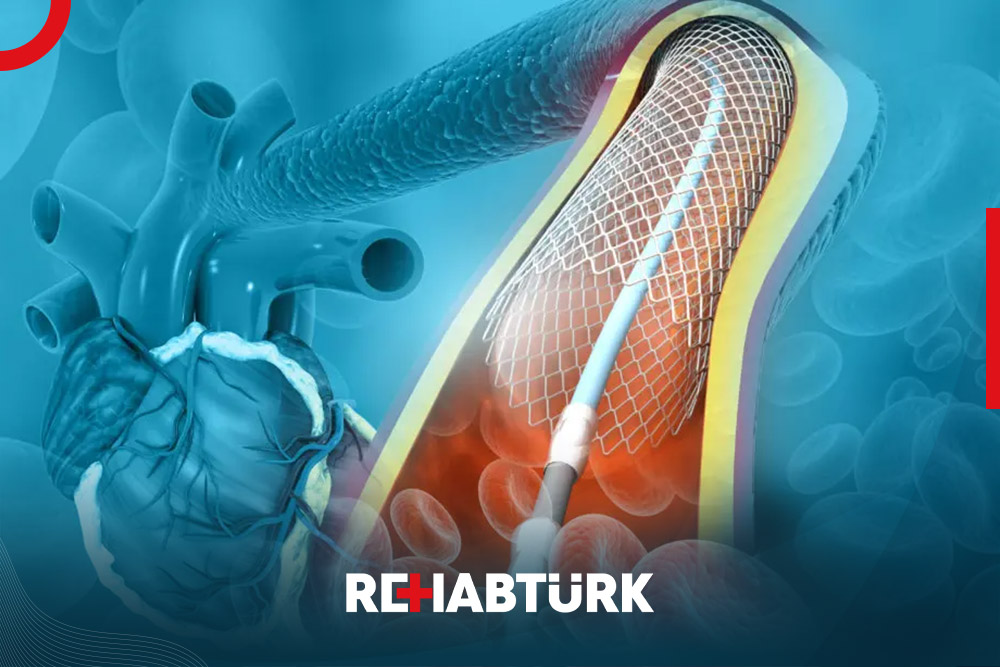Coronary angioplasty in Türkiye
Coronary angioplasty is a procedure used to widen blocked or narrowed coronary arteries (the main blood vessels that supply the heart ).
The term “angioplasty” means the use of a balloon to widen a narrowed or blocked artery. However, most modern angioplasty procedures also involve inserting a short tube of wire mesh, called a stent, into an artery during the procedure. The stent is left in place permanently to allow blood to flow more freely.

Coronary angioplasty is sometimes known as percutaneous angioplasty ( PTCA ). The combination of angioplasty and stenting is commonly referred to as percutaneous coronary intervention (PCI).
When do we resort to angioplasty?
Like all organs of the body, the heart needs a continuous supply of blood. This is supplied by the coronary arteries.
In older people, these arteries can become narrowed and hardened (known as atherosclerosis), which can cause coronary heart disease.
If blood flow to the heart becomes restricted, it can lead to chest pain known as angina, which is usually triggered by physical activity or stress.
While angina can often be treated with medication, we may have to have an operation to restore blood flow to the heart in severe cases where medication is not effective.
How is angioplasty performed?
Coronary angioplasty is performed using a local anesthetic, which means that you will be awake during the procedure.
A thin, flexible tube called a catheter will be inserted into an artery through an incision in the groin, wrist, or arm. This is directed at the affected coronary artery using a video X-ray .
When the catheter is in place, a thin wire is guided along the affected coronary artery, delivering a small balloon to the affected part of the artery. It is then inflated to widen the artery, crushing fatty deposits against the artery wall so blood can flow through it more freely when the deflated balloon is removed.
If a stent is used, this will be around the balloon before it is inserted. The bracket will expand when the balloon is inflated and stay in place when the balloon is deflated and removed.
Coronary angioplasty usually takes between 30 minutes and 2 hours. If you are being treated for angina, you will usually be able to go home later on the same day or the day after your operation. You’ll need to avoid heavy lifting, strenuous activities, and driving for at least a week.
If you were admitted to the hospital after having a heart attack, you may need to stay in the hospital for several days after the catheterization procedure before you go home.
How safe is angioplasty?
Coronary angioplasty is one of the most common types of heart treatment.
The procedure is most commonly performed in people 65 years of age or older, who are at a higher risk of heart disease.
Because the procedure does not involve making large incisions in the body, it is usually performed safely in most people. Doctors refer to this as a minimally invasive form of treatment.
The risk of serious complications from coronary angioplasty is generally small, but this depends on factors such as:
- Your age
- your general health
- Whether you have had a heart attack
Serious problems that can occur as a result of the procedure include:
- severe bleeding
- heart attack
- and stroke
Are there alternatives to angioplasty?
If several coronary arteries are blocked and narrowed, or if the structure of the arteries is abnormal, a CABG may be considered .
Where sections of healthy blood vessels are taken from other parts of the body and attached to the coronary arteries. Blood is diverted through these blood vessels, bypassing narrowed or blocked parts of the arteries.
Treatment in Türkiye:
The medical staff of surgical teams, doctors and consultants in REHABTÜRK can provide the best treatment options and free consultations – by striving to keep abreast of the latest medical technologies and methods.

